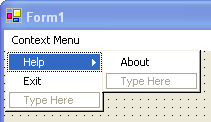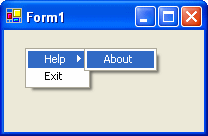Shows you how to make a context menu (right click / shortcut menu) in C# using Visual C# .NET and how to attach it to a control.
You can hardly find an application that doesn’t use any context menu. Adding a context menu to your application isn’t hard at all, thanks to Visual C# .NET.
Start a new Windows Application project. Look in the Toolbox for ContextMenu:

Add it to the form by double clicking or dragging. After the context menu is added to the application project, when you click on it at the top of the form, below the Title Bar the menu appears waiting to be edited. Of course, that’s not where the menu appears when you run the application. The menu appears when you right click the control.


Let’s add a few items to the menu. You can add new items just by clicking on the Type Here area. In the following screenshot you can see we added 3 items (Help -> About and Exit):

You can add code to the click event of an item the same way you would with any control. Select the item and switch to Events in the properties window and double click the Click event. This will take you to where you need to insert the code for the event. Here is the code for the event of the ‘Exit’ item:
private void menuItem3_Click(object sender, System.EventArgs e)
{
Application.Exit();
}Ok, we have created the context menu now we need to attach it to the control we need to have a context menu when it is right clicked.
You can attach a context menu to any control that has a ContextMenu property. To a Form, to a ListView, to a DataGrid, just use the Properties window to select a context menu:

And here’s the result to attaching the context menu to a form:




